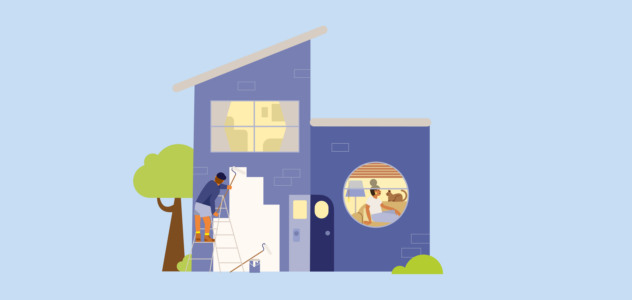Investors throw around the term “rental yield” like it’s glitter in a kid’s art class.
For good reason – rental yield is an essential figure to help you understand the rate of return you can expect from your investment property. And it can ultimately help you determine where you might invest and whether it’s worth it for you.
So, before you go all in on that investment property, let’s explore:
- What is rental yield?
- How to calculate rental yield
- What is a good rental yield?
- Positive gearing vs negative gearing
- How can you improve your rental yield?
- Is mortgage interest included in rental yield?
What is rental yield?
Simply, rental yield is the rental income you can expect from your investment property compared to its overall value.
It helps compare properties, for example: “does investment property A (in Melbourne) or investment property B (in Sydney) provide more or less rent when compared to its value?”
It’s often expressed as a percentage, with the higher percentage equating to a higher rental return (booyah).
There are two types of rental yield.
- Gross yield: your rental income before expenses
- Net yield: your rental income after expenses
While gross yield is a simpler calculation and can be useful for some purposes, net yield will give you a more realistic picture of what your investment returns will look like as it factors in ongoing expenses (ahem, important).
Why is rental yield important?
‘Rental yield’ is not just a fancy term investors use to fluff their financial feathers. It’s incredibly useful.
Calculating a rental yield can help you:
- Understand the performance of your investment property (or potential investment property) and compare it to other alternatives
- Achieve your investment goals
- Avoid making (costly) mistakes
- Make investment decisions that work for YOU
- Choose the right property and location to invest
So, now you know it’s an important figure – how is rental yield calculated?
How to calculate rental yield?
Let’s look at both gross and net rental yield.
How to calculate gross rental yield
Gross rental yield is the rent you charge annually, divided by the property value or purchase cost (then we multiply it by 100 so it’s represented as a percentage).
The formula
Rental income ➗ property value x 100 = gross rental yield.
Here’s an example:
Georgia is looking to purchase an investment property for $750 000. She plans to rent it out for $600 per week, expressed as an annual figure of $31,200 (600 x 52 weeks).
Now let’s do the calculation:
- Rental income divided by property value: 31,200 / 750,000 = 0.0416
- Multiply this by 100 to get a percentage (0.0416 x 100 = 4.16%)
- The gross rental yield is 4.16%
How to calculate net rental yield
Net rental yield is similar – only there’s an extra step to factor in your costs (like insurance, body coporate fees, land tax, repairs, building inspections, and maintenance fees). It’s the rent you charge annually, minus all fees, divided by the property value or purchase cost (then we multiply it by 100 so it’s represented as a percentage).
The formula
Rental income – fees and expenses ➗ property value x 100 = gross rental yield.
Here’s an example:
James is looking to purchase an investment property for $600,000. He calculates his annual fees and expenses to be $5000. He plans to rent the property for $550 per week, expressed as an annual figure of $28,600 (550 x 52 weeks).
Now let’s do the calculation:
- Rental income minus expenses: 28,600 – 5,000 = 23,600.
- Net rental income divided by the property value: 23,600 / 600,000 = 0.039
- Multiply this by 100 to get a percentage (0.039 x 100 = 3.93%)
- The net rental yield is 3.93%
Remember: net yield will give you a more realistic picture of what your investment returns will look like as it factors in ongoing expenses and helps you compare to other investment classes more easily.
Costs to consider when calculating your rental yield
“But Finspo, what costs do I actually need to include in my net rental yield calculation?”
Here are the most common:
- Any property maintenance or repairs
- Insurance
- Land tax
- Building and pest inspections
- Council rates
- Strata fees (if buying an apartment)
- Conveyancer or solicitor fees
Note: typically mortgage interest is excluded from rental yield calculations. Buuut it’s still an important consideration when thinking about your overall investment returns – let’s dive into this now.
What about mortgage interest, does that impact rental yield?
In a word, no.
Mortgage interest is typically not included in rental yield calculations because it’s considered a financing cost, not an operating expense. BUT – and it’s a big but – it’s still most likely the biggest influence on your overall investment returns (it’s probably the biggest ‘expense’ you have for your investment property).
So despite mortgage interest typically being tax deductible (AKA an expense incurred in generating income), you shouldn’t forget about it.
When running your calculations, it’s a good idea to review your rate (if you have an owner-occupied home loan AND an investment home loan, you may have more bargaining power).
Lost? Speak to a broker (like Finspo) to get started.
What is a good rental yield in Australia?
Now you’ve got your rental yield calculation, what does it even mean? What’s a ‘good’ rental yield?
Unfortunately, there’s no clear-cut answer.
But let’s just say this: The higher the rental yield, the better it may be for you, as it means you’re generating more income from your property. A higher rental yield is generally between 5 – 10%, while a lower rental yield is generally between 2 – 4%.
Buuut these figures don’t take into account potential capital growth (your property’s increasing value over time). For example, a high yield property may have very little capital growth, whereas a low yield property may have significant capital growth – it really depends.
So when calculating your rental yield and determining whether it’s ‘good’ – it’s important to take a rounded view of your investment strategy and consider capital growth. An investment advisor or tax professional can support you with this. A mortgage broker (or home loan expert) can then help you implement the strategy by supporting you with the lending components . That’s us!
So, is a higher rental yield better, then?
Not necessarily, because it all depends on your investment strategy.
For example, some investors intentionally look for properties with higher capital growth rates (even if they don’t have high rental yields) as part of a negative gearing strategy.
Let’s explore positive gearing vs negative gearing, shall we?
What is positive gearing?
Positive gearing is when the income generated from a property exceeds all expenses including the loan interest (AKA you’re making a profit). This is ideal for making immediate and regular income from your property (and also for those who are risk-averse).
What is negative gearing?
Negative gearing is when the expenses associated with owning an investment property exceed the rental income generated from that property (AKA you’re making a financial loss, at least for the short term).
So why would anyone want to do this? Well, there might be tax perks: the financial loss might be able to be offset against other income (such as your salary) for tax purposes. It may ultimately reduce the amount of tax you have to pay.
Often investors are willing to make a loss on property in the expectation they will achieve capital growth down the track (the value of the property is going up over time).
As the saying goes… short-term pain, for long-term gain?
As a side note: At Finspo, we’re home loan experts, not tax experts. We’ve described negative gearing in a generalised way for the purpose of illustrating general concepts in this article, but for more information related to tax legislation check out government websites or speak with your qualified accountant.
What property types get the best rental yield?
This is another “how long is a piece of string?” type of question.
But the property type and location you choose can impact your rental yield.
For example, apartments are often more affordable and in prime CBD locations. This also means they may generate higher rental returns (people are willing to pay more to live there) but they can have slower capital growth.
On the flip side, investing in a property with land in a regional or developing area may generate lower rental returns, but have a higher potential for capital growth.
Of course, this isn’t always the case, but just an example of how location and property type can influence your returns. See what we mean?
Can I improve my rental yield?
Yes. Essentially, you’ll need to make more income from your property (AKA increase the rent) or reduce your expenses. Or both.
Here are some tips to boost your rental income:
- Renovate or refresh (amazing what a lick of paint can do)
- Improve the energy efficiency of the home (this can make it more appealing to tenants, because who doesn’t love a cool home in the middle of an Aussie heatwave?)
- Improve safety and security
- Regularly review the rent to make sure it’s keeping up with the market
- Talk with a real estate agent about ways to improve rental yield on the property
Here are some tips to reduce your rental expenses:
- Negotiate with your real estate agent on their management fees
- Shop around for better energy rates (lower supply charges)
- Compare insurance prices
- Maintain the property regularly to avoid larger repair costs down the track
Tip: by doing a line-by-line review of your outgoings, you can identify where the biggest expenses are and determine where to focus your attention.
Ready to purchase an investment property or boost your rental yield?
If you’re thinking about purchasing your first investment property (look at you go, you property mogul) or you’re looking to boost your rental yield – our mortgage brokers (or home loan experts) can point you in the right direction. They can also connect you with other specialists such as tax accountants or financial planners.
Meeting with a Finspo home loan expert is easy, free and totally non-intimidating.




